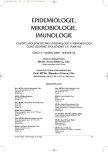In Vitro Activity of Commercially Available Disinfectants against Stenotrophomonas maltophilia
Authors:
V. Majtán; Ľ. Majtánová
Authors‘ workplace:
Slovenská zdravotnícka univerzita, Ústav preventívnej a klinickej medicíny, Bratislava
Published in:
Epidemiol. Mikrobiol. Imunol. 54, 2005, č. 2, s. 78-83
Overview
In vitro antibacterial efficacy of 14 commercially available disinfectants against the hospital pathogen Stenotrophomonas maltophilia was tested. The test disinfectants included 5 “pure” quartenary ammonium compounds (QACs) and 9 combination formulations with QACs as the major ingredient. Antibacterial efficacy was expressed as MIC, ED50and inhibition of the rate of incorporation of radioactive precursors [14C] adenine and [14C] leucine. Based on their activity, the disinfectants were divided into four groups. Group I characterized by high inhibitory activity (MIC 0.045–0.09 μg/ml) comprised benzalconium chloride and Triquart. Group II included formulations with good antibacterial activity (MIC 0.19–0.78 μg/ml) while group III formulations showed MICs between 1.56 and 25 μg/ml. The less active Cetrimid (MIC 50–100 μg/ml) was classified into group IV. When effects on biosynthetic processes expressed as R values (IC50Ade : IC50 Leu) were tested, R < 1 was only recorded for the following formulations: Hexaquart plus, Diesen forte, Sokrena, Forten, ID 212 and Cetrimid. Lower values of IC50 Ade and IC50 Leu are suggestive of effects on the synthesis of nucleic acids and proteins leading to inhibition of the two precursors. Endogenous respiration was almost 50 % inhibited by Cetrimid and Microbac forte at a concentration of 0.78 μg/ml, and 100 % inhibited by Almyrol, Diesen forte and Microbac forte at a concentration of 6.25 μg/ml and by FD312, Triquart, Hexaquart plus, Hexaquart S, ID 212, TPH 5225 at a concentration of 12.5 μg/ml.
Key words:
disinfectants – incorporation of [14C] precursors – respiration – Stenotrophomonas maltophilia.
Labels
Hygiene and epidemiology Medical virology Clinical microbiologyArticle was published in
Epidemiology, Microbiology, Immunology

2005 Issue 2
Most read in this issue
- Factors of Virulence and Mechanisms of Resistance to Aminoglycosides in Clinical Isolates of Enterococcus faecalis and Enterococcus faecium with High-level Gentamicin Resistance
- Congenital Toxoplasmosis: Possibilities for Laboratory Diagnosis
- Immunological Monitoring of Sepsis Using Flow Cytometry – Quantitation of Monocyte HLA-DR Expression and Granulocyte CD64 Expression
- Microbicidal Efficacy of a New Foam Disinfectant
